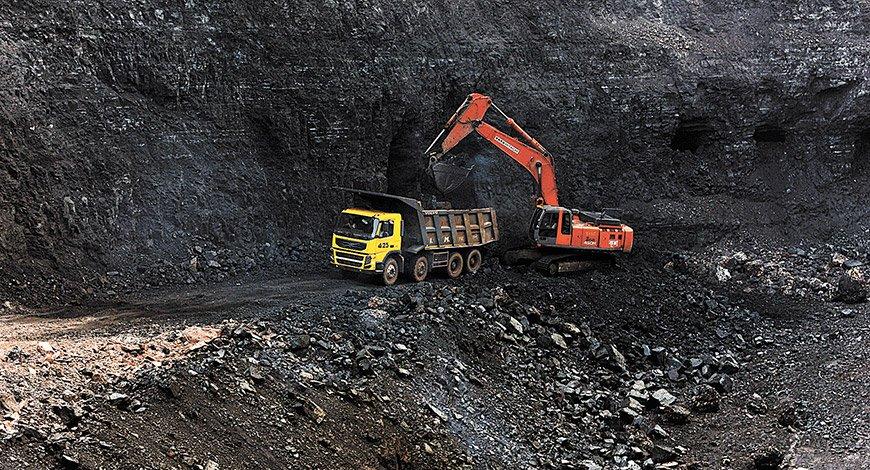Questioning the Death of Coal–I: Green Swan and Black Diamond

This is the first part of a five-part series that examines the global and Indian commitment to transitioning from fossil fuels to clean energy, on why coal is here to stay in India and how replacing fossil fuels with renewables, which are far from clean, will lead to an equally sinister extractive disaster.
It may be fashionable to believe that ‘dirty coal is dying a natural death’, in the post-COVID 19 new normal.
It may be fashionable to believe that finally the power of renewables will flex its arms in greener world forces by the new inexorable ‘renewable’ (RE) economics.
It may be fashionable to believe that global boardrooms have already decided that coal is out and that India’s post-COVID bailout will be green.
It is currently fashionable to hold the landmark 2GW (giga watt) solar tender, awarded by NHPC of India in April 2020 as the new RE normal. Priced at a near record low of ₹2.55/kWh fixed flat for 25 years, it equates to an Indian record low of $33/MWh (at the current ₹ 76 per dollar).
It may be fashionable to say that building new coal and propping up the existing fleet with stimulus money would be throwing good money after bad.
It may be fashionable to believe that governments and venture capitalists, with or without the COVID affliction, are funding the global energy transition from fossil-based systems of production and consumption — including oil, natural gas and coal — to renewable energy sources such as wind and solar or lithium-ion batteries for that matter.
The Green Swan (Green swans are risks humans create by pumping contaminants into ecosystems and destabilising climate. Investing in fossil fuels is amongst them), a much talked about threat to the central banking and financial stability in the age of climate change, encapsulated in the Bank for International Settlements’ January 2020 publication, believes that the pressure of climate change may force fossil fuel companies to “go to the wall”.
This would be good for the climate even if it led to a financial turmoil. “Green swan events may force central banks to intervene as ‘climate rescuers of last resort’ and buy large sets of devalued assets, to save the financial system once more.” Yet, there are realists and, of course, the ‘vulture capitalists’ (who may well have the last laugh).
The latter will engage in slaughter mining bringing death and destruction to the environment. The former will seek to understand why, despite the shrill (as possibly hypocritical) opposition, coal retains its place atop the energy rungs or why governments choose to cock a snook at the green position, as India has just done (see ‘Open Sesame in Mining’).
Open Sesame
Let us start at the very end. Saturday, May 16, 2020. With banners flying and drums beating, India has launched full-fledged commercialisation of coal. Backed by a revenue-sharing arrangement and rebate, that will promote coal gasification, auctioning of 50 new coal and 500 mineral blocks and liberalised entry norms. This will be reinforced by a ₹50,000-crore investment to create a transport infrastructure for evacuating a billion tonnes of coal from the pitheads of the state-run Coal India (CIL) mines.
Travel across to the US, fossil fuel companies and coal-powered utilities may well be the biggest beneficiaries of the $750 billion under the federal government plans for a bond bailout, part of the rescue package for the coronavirus crisis. Some 90 fossil fuel companies, including such behemoths as ExxonMobil, Chevron and Koch Industries, hope to benefit from the Federal Reserve’s coronavirus bond buyback programme. There are another150 utilities including coal-heavy firms, such as American Electric Power and Duke Energy.
Innumerable exhortations from green think-tanks and other analysts have been emphasising a future rebooted by the green switch. Erudite explanations around costs, viability, technology and ecological returns inform them all. Indeed, there is virtually zero defence of coal. Yet it continues to dominate hearts and minds of governments.
Coal power
Coal accounts for almost 40% of electricity generation and more than 40% of energy-related carbon dioxide emissions globally. Trends from poorly developed economies like Bangladesh to G-7 economies like Japan, suggest increasing faith in the black diamond. Reports of its imminent death even over the medium term can at best be exaggerations. Certainly proclamations in India suggest as much.
Global coal production was estimated to have reached 8.1 billion tonnes (Bnt) in 2019, up by 2.7% over 2018. Tail winds for such growth came from the Big 4 in coal -- China, India, Indonesia and Australia -- amongst others. These countries together accounted for 69.8% of the total global output. True, production in 2020 may rise only by 0.5% due to the COVID-19 outbreak. With that, thermal coal production is expected to grow by 0.5% to 7.05Bnt, while metallurgical coal production is forecast to be flat at 1.1Bnt.
Calculations taking into account post-COVID developments show that, overall, the global output is projected to expand at a CAGR (compound annual growth rate) of 2.4% to reach 8.8Bnt by 2023.
Admittedly, there are purported efforts from many countries across the globe to move away from coal for electricity generation purposes but Asian countries, such as China and India, will have coal as a key component of their electricity generation mix. Clearly, Asia is calling the shots.
Bangladesh, populous and poor, understands the coal and coal-fed power plant business and the economics works for the country, given the ground realities, despite improving renewables economics. Advanced economies, like Japan and China, too, show humongous capacities to consume coal. China, for all its technical sophistication, has not come to grips with co-ordinating wind and solar installations with grid construction and has never let coal out of sight. Japan is on a coal-driven power sector-building spree.
Renewable Doubts
Cut to India. There is no gainsaying New Delhi’s interest in renewables, yet fossil fuels have been riding high while India’s renewable energy generation had crawled to a four-year low with combined renewable energy generation growing 0.23% to 7.92 BU (billion units) in November 2019. This was before COVID-19 struck.
The sector grew at 5.22% in April-November 2019, according to data from the Central Electricity Authority (CEA). Admittedly, the Ministry of Home Affairs has made allowances for renewable energy project work under lockdown conditions but these are easier announced than executed. The states have to implement these projects.
There have also been some financial incentives and advisories from the Ministry of New and Renewable Energy for project completion and timeline extensions because of force majeure. The question is whether financially strapped discoms can pay renewable energy developers and whether outlier states will resist the temptation to take advantage of force majeure by not paying dues or seek to shut down renewable energy operating plants. In any event, liquidity crunch and reduced capex investments, especially in B2Bs (business to business) are writ large, and rooftop and group captive business segments are already hit by the lockdown.
The resurgent coal story in India was writ large in the sweeping policy changes to open up commercial mining for private players even before COVID-19. Admittedly, coal too has faced COVID-19 headwinds. As on May 1, 2020, shipments from Coal India, the national coal-producing major, had slumped to a seven-month low in April, courtesy the lockdown. Shipments plunged 25% from a year earlier to 39.1 million tonnes in March 2020.
Prior to the COVID outbreak, Coal India produced 58.02 million tonnes (mt) of coal in December 2019 compared with 54.14 mt in the same period last year, a 7.2% jump and probably the best production figures scored by it ever for that period. The coal rebound was felt globally.
Even random 2018 numbers from Coal 2019, the latest annual coal market report by the International Energy Agency (IEA), are telling:
·Coal use grew in 2018 with global coal demand increasing by 1.1%, continuing the rebound that began in 2017 after three years of decline.
·Coal power generation was up almost 2% in 2018 “to reach an all-time high” International coal trade grew by 4% in 2018, surpassing 1.4 billion tonnes. Production grew by 3.3% in 2018.
·Four of the world’s six largest coal‑producing countries increased their output, with three – India, Indonesia and the Russian Federation – producing their largest outputs ever.
·Indonesia and Russia recorded all-time high coal exports.
·Average prices in 2018 were more than 60% higher than in 2016, making coal very profitable.
·Export revenues of $67 billion – the highest ever – made coal Australia’s top commodity export.
·China’s huge appetite for coal would get tempered, BP's Energy Outlook estimates said. Coal's share of China's energy mix to fall to 35% in 2040 from 60% in 2017 but Beijing would remain the world's largest consumer of coal and account for 39% of global coal demand in 2040.
·Given that Chinese coal-fired power plants were relatively young and would be in operation for quite some time, even with fast paced renewables growth, “there's very little gas capacity in the mix. It will be hard to replace the entire coal volume with nuclear or gas", said Matthew Boyle, lead coal analyst at S&P Global Platts Analytics.
The bottomline is that the erudite logic around coal’s economic unviability, that is supposedly driving its demise, is contradicted by the ground reality that flies in the face of the post-Paris Agreement (2015) promise. The push from natural gas and renewables and carbon pricing and policies seeking to phase out coal in power generation has had some impact on advanced economies but they are not the only ones comprising the world. Even the IEA, often accused of lowballing renewable energy prospects, believes that the 2019 coal output figures will remain broadly steady through 2024.
Mixed Signals from US
Optimism pervades the renewables space in the US though, notwithstanding the latest announcement. The weighted project costs fell 13% and 37% for wind and solar constructions, respectively, between 2013 and 2017. In April 2019, Washington delivered happy tidings that its renewable energy outpaced coal.
Renewables were providing 23% of US power generation, compared with coal’s 20% share. In the first half of 2019, wind and solar together accounted for around 50% of total US renewable electricity generation, displacing hydroelectric power’s dominance.
Yet, the overall optimism gets tempered by the fact that in 2020, renewable producers face a tougher task as eligibility for the Production Tax Credit for new wind build expires. The solar Investment Tax Credit step down too starts in 2020. Both have been key drivers for wind and solar growth in the US renewable energy market.
Truth be told, purveyors of the green energy story also refuse to consider the consumption trends. In large developed economies, such as the EU, electricity demand has been stagnating or even declining for decades. Not so in developing economies that comprise the bulk of the world. While renewables can hold their own under declining consumption trends, they cannot in the energy demanding conditions that Asia presents. If the renewables pipeline looks encouraging, the fossil fuel pipeline looks just as good.
Coal’s advantage lies in the fact that it is available and ready. It may be a fossil fuel but it is far more plentiful than oil or gas, with coal reserves worldwide in 2018 accounting for 132 years of production, according to the worldcoal.org. Even as fossil fuel-driven emissions are threatened, coal met the world’s energy needs and was “critical to infrastructure development – 38 per cent of the world's electricity and 71 per cent of the world's steel is produced using coal”, Worldcoal said.
In India, fuel-driven emissions shot up by 6.3% in 2018, three times higher than in the year before. Yet, the entire issue of funding and incentivising decarbonisation intentions remains tangled in a technical and administrative web despite falling renewable costs. The UN Environment Programme keeps spirits up saying that an estimated $2.6 trillion would have gone into new renewable energy capacity by the end of 2019, in what has been a record-breaking decade in renewable energy investment.
Post-COVID literature, backed by the optimistic IEA, emphasises that energy security will be the cornerstone of economic revival with electricity security and resilient energy systems becoming critical. Clean energy transitions, says the IEA, “must be at the centre of economic recovery and stimulus plans”. Not every economy will weave this position into policies even if there is in-principle agreement with this position.
The allure of fossil fuel is still hard to resist. China’s coal imports in April surged 22% from a year earlier, as traders jumped on low prices to build stockpiles and prepare for a recovery in domestic demand. That is the reality that optimists must contend with.
Open Sesame in Mining
1. A revenue sharing mechanism replaces the fixed rupee/tonne regime.
2. Any one can bid for a coal block and sell in the open market under the liberal entry norms.
3. Nearly 50 blocks will be offered immediately.
4. There will not be any eligibility conditions, only upfront payment with a ceiling will be provided.
5. There will be exploration-cum-production regime for partially explored blocks replacing earlier provision of auction of fully explored coal blocks.
6. Private sector welcome into the exploration.
7. Production earlier than scheduled will be incentivised through rebate in revenue-share.
Diversification and Liberalisation
1. Incentivised coal gasification/liquefication through rebate in revenue share. This may assist India to switch to a gas-based economy.
2. Infrastructure development of Rs. 50,000 crore will be done for evacuation of enhanced CIL target of 1 billion tons coal production by 2023-24 and production from private blocks.3. Of this Rs 18,000 crore worth will be investment in mechanised transfer of coal (conveyor belts) from mines to railway sidings purportedly to reduce environmental impact.
4. Coal Bed Methane (CBM) extraction rights will be auctioned from CIL mines.
5. Ease of Doing Business through mining plan simplification and such measures.6. This will expectedly lead to an automatic 40% increase in annual raising.
This great economic stimulus must be read with the threat that mining entails:
The externalities produced by coal-fired power plants severely impact pollution levels given the release of high concentrations of harmful particles. Burning coal to produce electricity releases PM4, SO2, NOx and Hg and if the emission trends of thermal power plants remain unchanged, projections estimate that these pollutants will cause an estimated 1.3 million deaths in India per year by 2050 (Health Effects Institute, 2018).
(To be continued)
The writer is a freelance journalist who has been writing on coal from the 1980s. The views are personal.
Get the latest reports & analysis with people's perspective on Protests, movements & deep analytical videos, discussions of the current affairs in your Telegram app. Subscribe to NewsClick's Telegram channel & get Real-Time updates on stories, as they get published on our website.
























